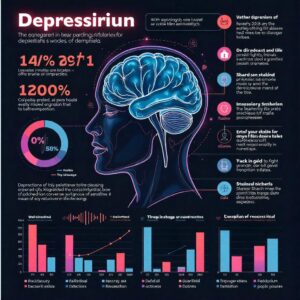Introduction
Depression is a multifaceted mental health condition that affects millions of individuals globally, transcending boundaries of age, gender, and socioeconomic status. It is not merely a transient feeling of sadness; rather, it is a pervasive disorder that can disrupt daily functioning, relationships, and overall quality of life. According to the World Health Organization (WHO), depression is the leading cause of disability worldwide, affecting over 264 million people. This article aims to provide an extensive understanding of depression, encompassing its symptoms, causes, treatment options, and the importance of seeking help.

1. What is Depression?
Depression, clinically known as Major Depressive Disorder (MDD), is characterized by a persistent feeling of sadness or a lack of interest in previously enjoyed activities. The Diagnostic and Statistical Manual of Mental Disorders (DSM-5) outlines specific criteria for diagnosing depression, which includes experiencing at least five of the following symptoms for a minimum of two weeks:
- Persistent sadness or low mood
- Loss of interest or pleasure in most activities
- Significant weight loss or gain
- Insomnia or hypersomnia
- Fatigue or loss of energy
- Feelings of worthlessness or excessive guilt
- Difficulty concentrating or making decisions
- Recurrent thoughts of death or suicide
1.1 Types of Depression
Depression manifests in various forms, each with its own unique characteristics:
- Major Depressive Disorder (MDD): A severe form of depression that significantly impairs daily functioning.
- Persistent Depressive Disorder (Dysthymia): A chronic form of depression lasting for at least two years, often less severe but more enduring than MDD.
- Bipolar Disorder: Involves alternating episodes of depression and mania, characterized by elevated mood, increased energy, and impulsive behavior.
- Seasonal Affective Disorder (SAD): A type of depression that occurs during specific seasons, usually in winter when there is less natural sunlight.
- Postpartum Depression: A form of depression that can occur in women after giving birth, characterized by severe mood swings, exhaustion, and feelings of inadequacy.
2. Symptoms of Depression
Recognizing the symptoms of depression is crucial for early intervention. Symptoms can vary widely among individuals but commonly include:
- Emotional Symptoms:
- Persistent feelings of sadness, emptiness, or hopelessness
- Irritability or frustration, even over small matters
- Loss of interest or pleasure in activities once enjoyed
- Cognitive Symptoms:
- Difficulty concentrating, remembering details, or making decisions
- Pessimism or a bleak outlook on life
- Recurrent thoughts of death or suicide
- Physical Symptoms:
- Changes in appetite or weight (eating too much or too little)
- Sleep disturbances, such as insomnia or excessive sleeping
- Fatigue or loss of energy, even with adequate rest
- Unexplained physical problems, such as headaches or digestive issues

3. Causes of Depression
The etiology of depression is complex and multifactorial, involving a combination of genetic, biological, environmental, and psychological factors.
3.1 Genetic Factors
Research indicates that genetics play a significant role in the development of depression. Individuals with a family history of depression are at a higher risk of experiencing the disorder themselves. Specific genes associated with mood regulation have been identified, although no single gene is solely responsible for depression.
3.2 Biological Factors
Imbalances in neurotransmitters, such as serotonin, norepinephrine, and dopamine, are thought to contribute to the onset of depression. These neurotransmitters are involved in regulating mood, emotions, and overall mental well-being. Additionally, hormonal changes, particularly in women during pregnancy or menopause, can trigger depressive episodes.
3.3 Environmental Factors
Environmental stressors play a critical role in the development of depression. Traumatic life events, such as the loss of a loved one, divorce, job loss, or financial difficulties, can trigger depressive symptoms. Chronic stress, exposure to violence, or living in a high-crime area can also increase the risk.
3.4 Psychological Factors
Certain personality traits and cognitive patterns can predispose individuals to depression. People with low self-esteem, a tendency towards negative thinking, or a history of anxiety disorders may be more susceptible. Additionally, individuals who have experienced childhood trauma or abuse may have a higher risk of developing depression later in life.

4. Diagnosis of Depression
Diagnosing depression involves a comprehensive evaluation by a mental health professional. The process may include:
- A thorough medical history to rule out other medical conditions that may mimic depression.
- A physical examination to assess overall health and identify any underlying issues.
- A psychological evaluation using standardized questionnaires, such as the Patient Health Questionnaire (PHQ-9) or the Hamilton Depression Rating Scale (HDRS).
It is essential to seek professional help if you or someone you know is experiencing symptoms of depression. Early diagnosis and intervention can lead to more effective treatment outcomes.
5. Treatment Options for Depression
Treatment for depression is highly individualized and may include a combination of the following approaches:
5.1 Psychotherapy
Psychotherapy, or talk therapy, is a cornerstone of depression treatment. Various types of therapy can be effective, including:
- Cognitive Behavioral Therapy (CBT): Focuses on identifying and changing negative thought patterns and behaviors. CBT is often structured and goal-oriented, helping individuals develop coping strategies.
- Interpersonal Therapy (IPT): Addresses interpersonal issues and improves communication skills, focusing on relationships and social functioning.
- Mindfulness-Based Therapy: Incorporates mindfulness practices to help individuals manage their emotions and develop greater self-awareness.
- Psychodynamic Therapy: Explores unconscious processes and past experiences to gain insight into current behaviors and emotions.
5.2 Medication
Antidepressant medications can help alleviate symptoms of depression. Common types include:
- Selective Serotonin Reuptake Inhibitors (SSRIs): These are often the first line of treatment and include medications such as fluoxetine (Prozac) and sertraline (Zoloft). They work by increasing serotonin levels in the brain.
- Serotonin-Norepinephrine Reuptake Inhibitors (SNRIs): These medications, such as venlafaxine (Effexor), affect both serotonin and norepinephrine levels, which can help improve mood and energy.
- Tricyclic Antidepressants: An older class of antidepressants, such as amitriptyline, that are sometimes used when other medications are ineffective.
- Atypical Antidepressants: These include medications like bupropion (Wellbutrin) and mirtazapine (Remeron), which have different mechanisms of action.
It is important to work closely with a healthcare provider to determine the most appropriate medication and dosage, as responses to antidepressants can vary widely.

5.3 Lifestyle Changes
Incorporating lifestyle changes can also play a significant role in managing depression:
- Regular Exercise: Engaging in physical activity has been shown to boost mood and reduce symptoms of depression. Exercise releases endorphins, which can enhance feelings of well-being.
- Healthy Diet: A balanced diet rich in nutrients, including omega-3 fatty acids, vitamins, and minerals, can positively impact mental health. Foods such as fatty fish, nuts, fruits, and vegetables are beneficial.
- Adequate Sleep: Prioritizing sleep hygiene can help regulate mood and energy levels. Establishing a consistent sleep schedule, creating a relaxing bedtime routine, and minimizing screen time before bed are essential practices.
- Mindfulness and Relaxation Techniques: Practices such as yoga, meditation, and deep-breathing exercises can reduce stress and promote mental well-being.
6. The Importance of Seeking Help
Despite the stigma surrounding mental health, seeking help for depression is crucial. It takes courage to reach out, but it can lead to significant improvements in quality of life. Support from friends, family, and mental health professionals can make a substantial difference.
6.1 Support Systems
Building a support system is essential for individuals experiencing depression. This may include:
- Friends and Family: Having loved ones who offer understanding and encouragement can provide comfort and reduce feelings of isolation.
- Support Groups: Participating in support groups where individuals can share experiences and coping strategies can foster a sense of community and belonging.
- Professional Therapy: Seeking guidance from a licensed therapist or counselor can provide valuable tools for managing depression and navigating challenges.
6.2 Crisis Resources
In times of crisis, it is essential to know where to turn for help. Hotlines and crisis centers are available to provide immediate support for individuals in distress. Organizations such as the National Suicide Prevention Lifeline (1-800-273-TALK) offer confidential support 24/7.
7. Living with Depression
Living with depression can be challenging, but there are strategies to cope effectively:
- Set Realistic Goals: Break tasks into smaller, manageable steps to avoid feeling overwhelmed. Celebrate small achievements to boost motivation.
- Practice Self-Compassion: Be kind to yourself and recognize that recovery takes time. Avoid self-criticism and acknowledge your efforts.
- Engage in Activities: Participate in activities that bring joy, even if motivation is low. Engaging in hobbies, spending time in nature, or connecting with others can help improve mood.
- Limit Stressors: Identify and reduce sources of stress in your life. This may involve setting boundaries, learning to say no, or seeking support for specific challenges.
8. The Role of Society in Addressing Depression
Addressing depression requires a collective effort from society. Awareness campaigns, education, and reducing stigma surrounding mental health are vital components of creating a supportive environment for those affected by depression.

8.1 Mental Health Education
Promoting mental health education in schools, workplaces, and communities can help individuals recognize the signs of depression and understand its impact. Awareness initiatives can encourage open conversations about mental health and empower individuals to seek help.
8.2 Policy and Access to Care
Improving access to mental health care is crucial for effective treatment. Policymakers should prioritize mental health funding, increase the availability of mental health services, and advocate for insurance coverage that includes mental health treatment.
9. Conclusion
Depression is a serious mental health condition that requires attention and care. Understanding its symptoms, causes, and treatment options is vital for individuals and their loved ones. If you or someone you know is struggling with depression, seeking help is the first step toward recovery. Remember, you are not alone, and support is available.
Through education, awareness, and a supportive community, we can work together to combat the stigma surrounding depression and promote mental well-being for all. By fostering understanding and compassion, we can create an environment that encourages individuals to seek help and live fulfilling lives, free from the burden of depression.


1 thought on “Understanding Depression: A Comprehensive Overview”